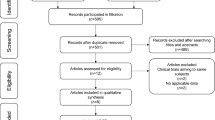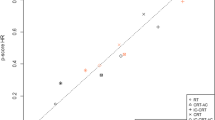Abstract
Purpose
The current study set out to compare the efficacies and toxicities (grad 3 and 4) between concurrent chemoradiotherapy (CCRT), induction chemotherapy plus radiotherapy (IC + RT), IC + CCRT, RT and CCRT + adjuvant chemotherapy (CCRT + AC) in regard to advanced nasopharyngeal carcinoma (NPC) treatment using a network meta-analysis.
Methods
Literature retrieval was conducted using PubMed, Cochrane Library and other English databases. Eligible randomized controlled trails (RCTs) of 5 different regimens were included. The network meta-analysis combined direct and indirect comparisons to measure pooled odd ratios (OR) and the surface under the cumulative ranking curves (SUCRA).
Results
A total of eight eligible RCTs were enrolled into this network meta-analysis after initial exclusion. With respect to hematologic toxicity, CCRT + AC exhibited higher toxicity in patients with advanced NPC in terms of anemia and leukopenia/neutropenia compared to RT. As for anemia, the toxicity of IC + CCRT was higher than those with advanced NPC. In addition, CCRT exhibited higher toxicity than RT in relation to leukopenia/neutropenia. Non-hematologic toxicity in regard to nausea/vomiting suggested that CCRT, IC + CCRT and CCRT + AC presented with higher levels of toxicity in patients with advanced NPC, in contrast to RT. Lastly, RT was found to be less toxic but with higher five-year overall survival (OS) rate in patients with advanced NPC, while CCRT, IC + CCRT and CCRT + AC were more toxic in patients with advanced NPC.
Conclusion
Among the five therapeutic regimens, the survival rate of IC + RT was similar to that of CCRT, and the toxicity SUCRA value of IC + RT was lower than that of CCRT. Together, our findings indicate that IC + RT may be a potentially acceptable treatment alternative to CCRT for advanced NPC, and is worthy of further investigation.




Similar content being viewed by others
References
Tan G, Tang X, Tang F (2015) The role of microRNAs in nasopharyngeal carcinoma. Tumour Biol 36:69–79
Huang PY, Zeng Q, Cao KJ et al (2015) Ten-year outcomes of a randomised trial for locoregionally advanced nasopharyngeal carcinoma: a single-institution experience from an endemic area. Eur J Cancer 51:1760–1770
Zhao M, Luo R, Liu Y et al (2016) miR-3188 regulates nasopharyngeal carcinoma proliferation and chemosensitivity through a FOXO1-modulated positive feedback loop with mTOR-p-PI3K/AKT-c-JUN. Nat Commun 7:11309
Xiao C, Wang L, Jiao Y et al (2013) Long-term results of concurrent chemoradiotherapy for T3/T4 locally advanced nasopharyngeal carcinoma. Mol Clin Oncol 1:507–510
Cooper JS (2000) Concurrent chemotherapy and radiation therapy for advanced stage carcinoma of the nasopharynx. Int J Radiat Oncol Biol Phys 48:1277–1279
Chia WK, Teo M, Wang WW et al (2014) Adoptive T-cell transfer and chemotherapy in the first-line treatment of metastatic and/or locally recurrent nasopharyngeal carcinoma. Mol Ther 22:132–139
Becker-Schiebe M, Christiansen H (2015) Update on combined radio-, radiochemo-, and chemotherapy alone in multimodal therapy of nasopharyngeal carcinoma–a MAC-NPC meta-analysis. Strahlenther Onkol 191:991–993
Chen CY, Han F, Zhao C et al (2009) Treatment results and late complications of 556 patients with locally advanced nasopharyngeal carcinoma treated with radiotherapy alone. Br J Radiol 82:452–458
Sun X, Su S, Chen C et al (2014) Long-term outcomes of intensity-modulated radiotherapy for 868 patients with nasopharyngeal carcinoma: an analysis of survival and treatment toxicities. Radiother Oncol 110:398–403
Lu H, Peng L, Yuan X et al (2009) Concurrent chemoradiotherapy in locally advanced nasopharyngeal carcinoma: a treatment paradigm also applicable to patients in Southeast Asia. Cancer Treat Rev 35:345–353
Peng H, Chen L, Zhang Y et al (2016) The tumour response to induction chemotherapy has prognostic value for long-term survival outcomes after intensity-modulated radiation therapy in nasopharyngeal carcinoma. Sci Rep 6:24835
Chen C, Zhang M, Xu Y et al (2016) Unidimensional measurement may evaluate target lymph nodal response after induction chemotherapy for nasopharyngeal carcinoma. Med (Baltim) 95:e2667
Yan M, Kumachev A, Siu LL, Chan KK (2015) Chemoradiotherapy regimens for locoregionally advanced nasopharyngeal carcinoma: a Bayesian network meta-analysis. Eur J Cancer 51:1570–1579
Higgins JP, Altman DG, Gotzsche PC et al (2011) The Cochrane Collaboration’s tool for assessing risk of bias in randomised trials. BMJ 343:d5928
Chung JH, Lee SW (2013) Assessing the quality of randomized controlled urological trials conducted by korean medical institutions. Korean J Urol 54:289–296
Chen LX, Li YL, Ning GZ et al (2015) Comparative efficacy and tolerability of three treatments in old people with osteoporotic vertebral compression fracture: a network meta-analysis and systematic review. PLoS ONE 10:e0123153
Tu YK, Needleman I, Chambrone L, Lu HK, Faggion CM Jr (2012) A Bayesian network meta-analysis on comparisons of enamel matrix derivatives, guided tissue regeneration and their combination therapies. J Clin Periodontol 39:303–314
Zhu GQ, Shi KQ, Huang S et al (2015) Systematic review with network meta-analysis: the comparative effectiveness and safety of interventions in patients with overt hepatic encephalopathy. Aliment Pharmacol Ther 41:624–635
Chaimani A, Higgins JP, Mavridis D, Spyridonos P, Salanti G (2013) Graphical tools for network meta-analysis in STATA. PLoS ONE 8:e76654
Salanti G, Ades AE, Ioannidis JP (2011) Graphical methods and numerical summaries for presenting results from multiple-treatment meta-analysis: an overview and tutorial. J Clin Epidemiol 64:163–171
Chen L, Hu CS, Chen XZ et al (2012) Concurrent chemoradiotherapy plus adjuvant chemotherapy versus concurrent chemoradiotherapy alone in patients with locoregionally advanced nasopharyngeal carcinoma: a phase 3 multicentre randomised controlled trial. Lancet Oncol 13:163–171
Chen QY, Wen YF, Guo L et al (2011) Concurrent chemoradiotherapy vs radiotherapy alone in stage II nasopharyngeal carcinoma: phase III randomized trial. J Natl Cancer Inst 103:1761–1770
Fountzilas G, Ciuleanu E, Bobos M et al (2012) Induction chemotherapy followed by concomitant radiotherapy and weekly cisplatin versus the same concomitant chemoradiotherapy in patients with nasopharyngeal carcinoma: a randomized phase II study conducted by the Hellenic Cooperative Oncology Group (HeCOG) with biomarker evaluation. Ann Oncol 23:427–435
Huang PY, Cao KJ, Guo X et al (2012) A randomized trial of induction chemotherapy plus concurrent chemoradiotherapy versus induction chemotherapy plus radiotherapy for locoregionally advanced nasopharyngeal carcinoma. Oral Oncol 48:1038–1044
Lee AW, Tung SY, Chua DT et al (2010) Randomized trial of radiotherapy plus concurrent-adjuvant chemotherapy vs radiotherapy alone for regionally advanced nasopharyngeal carcinoma. J Natl Cancer Inst 102:1188–1198
Li WF, Li YQ, Chen L et al (2015) Propensity-matched analysis of three different chemotherapy sequences in patients with locoregionally advanced nasopharyngeal carcinoma treated using intensity-modulated radiotherapy. BMC Cancer 15:810
Wee CW, Keam B, Heo DS et al (2015) Locoregionally advanced nasopharyngeal carcinoma treated with intensity-modulated radiotherapy plus concurrent weekly cisplatin with or without neoadjuvant chemotherapy. Radiat Oncol J 33:98–108
Xu T, Hu C, Wang X, Shen C (2011) Role of chemoradiotherapy in intermediate prognosis nasopharyngeal carcinoma. Oral Oncol 47:408–413
Zhang L, Tang LQ, Chen QY et al (2016) Plasma Epstein-Barr viral DNA complements TNM classification of nasopharyngeal carcinoma in the era of intensity-modulated radiotherapy. Oncotarget 7:6221–6230
Guo Q, Lu T, Lin S et al (2016) Long-term survival of nasopharyngeal carcinoma patients with Stage II in intensity-modulated radiation therapy era. Jpn J Clin Oncol 46:241–247
OuYang PY, Shi D, Sun R et al (2016) Effect of intensity-modulated radiotherapy versus two-dimensional conventional radiotherapy alone in nasopharyngeal carcinoma. Oncotarget 7:33408–33417
Peng G, Wang T, Yang KY et al (2012) A prospective, randomized study comparing outcomes and toxicities of intensity-modulated radiotherapy vs. conventional two-dimensional radiotherapy for the treatment of nasopharyngeal carcinoma. Radiother Oncol 104:286–293
Wu MY, He XY, Hu CS (2016) Tumor Regression and Patterns of Distant Metastasis of T1–T2 Nasopharyngeal Carcinoma with Intensity-Modulated Radiotherapy. PLoS ONE 11:e0154501
Lee AW, Ng WT, Chan YH et al (2012) The battle against nasopharyngeal cancer. Radiother Oncol 104:272–278
Ji X, Xie C, Hu D et al (2013) Survival benefit of adding chemotherapy to intensity modulated radiation in patients with locoregionally advanced nasopharyngeal carcinoma. PLoS ONE 8:e56208
Blanchard P, Lee A, Marguet S et al (2015) Chemotherapy and radiotherapy in nasopharyngeal carcinoma: an update of the MAC-NPC meta-analysis. Lancet Oncol 16:645–655
Zatloukal P, Petruzelka L, Zemanova M et al (2004) Concurrent versus sequential chemoradiotherapy with cisplatin and vinorelbine in locally advanced non-small cell lung cancer: a randomized study. Lung Cancer 46:87–98
Fournel P, Robinet G, Thomas P et al (2005) Randomized phase III trial of sequential chemoradiotherapy compared with concurrent chemoradiotherapy in locally advanced non-small-cell lung cancer: groupe Lyon-Saint-Etienne d’Oncologie Thoracique-Groupe Francais de Pneumo-Cancerologie NPC 95–01 Study. J Clin Oncol 23:5910–5917
Zhang AM, Fan Y, Wang XX et al (2012) Increased treatment-related mortality with additional cisplatin-based chemotherapy in patients with nasopharyngeal carcinoma treated with standard radiotherapy. Radiother Oncol 104:279–285
Chen YP, Wang ZX, Chen L et al (2015) A Bayesian network meta-analysis comparing concurrent chemoradiotherapy followed by adjuvant chemotherapy, concurrent chemoradiotherapy alone and radiotherapy alone in patients with locoregionally advanced nasopharyngeal carcinoma. Ann Oncol 26:205–211
Wee J, Tan EH, Tai BC et al (2005) Randomized trial of radiotherapy versus concurrent chemoradiotherapy followed by adjuvant chemotherapy in patients with American Joint Committee on Cancer/International Union against cancer stage III and IV nasopharyngeal cancer of the endemic variety. J Clin Oncol 23:6730–6738
Miah AB, Bhide SA, Del Rosario L et al (2016) Induction Chemotherapy Followed by Chemo-intensity-modulated Radiotherapy for Locally Advanced Nasopharyngeal Cancer. Clin Oncol (R Coll Radiol) 28:e61-67
Lumley T (2002) Network meta-analysis for indirect treatment comparisons. Stat Med 21:2313–2324
Author information
Authors and Affiliations
Corresponding author
Ethics declarations
Conflict of interest
The authors declare no conflicts of interest exist in this work.
Additional information
Publisher's Note
Springer Nature remains neutral with regard to jurisdictional claims in published maps and institutional affiliations.
Supplementary Information
Below is the link to the electronic supplementary material.
405_2020_6593_MOESM1_ESM.eps
Supplementary file1 (EPS 891 KB) Supplementary Fig. 1 Flow chart of literature screening and a total of eight eligible RCTs are enrolled in this network meta-analysis.
405_2020_6593_MOESM2_ESM.eps
Supplementary file2 (EPS 1015 KB) Supplementary Fig. 2 Relative relationship forest plots of thrombocytopenia and mucositis of five therapeutic regimens in the treatment of advanced NPC. A = CCRT (concurrent chemoradiotherapy); B = IC plus RT (induction chemotherapy plus radiotherapy); C = IC plus CCRT (induction chemotherapy plus concurrent chemoradiotherapy); D = RT (radiotherapy); E = CCRT plus AC (concurrent chemoradiotherapy plus adjuvant chemotherapy).
405_2020_6593_MOESM3_ESM.eps
Supplementary file3 (EPS 1009 KB) Supplementary Fig. 3 Relative relationship forest plots of dysphagia and dermatitis of five therapeutic regimens in the treatment of advanced NPC. A = CCRT (concurrent chemoradiotherapy); B = IC plus RT (induction chemotherapy plus radiotherapy); C = IC plus CCRT (induction chemotherapy plus concurrent chemoradiotherapy); D = RT (radiotherapy); E = CCRT plus AC (concurrent chemoradiotherapy plus adjuvant chemotherapy).
Rights and permissions
About this article
Cite this article
Li, T., Yang, F., Ma, K. et al. A network meta-analysis for efficacies and toxicities of different therapeutic regimens in the treatment of advanced nasopharyngeal carcinoma. Eur Arch Otorhinolaryngol 278, 3333–3344 (2021). https://doi.org/10.1007/s00405-020-06593-5
Received:
Accepted:
Published:
Issue Date:
DOI: https://doi.org/10.1007/s00405-020-06593-5




